ENG101 Essay: The Great Vowel Shift and Modern English Accents
VerifiedAdded on 2022/08/11
|6
|1618
|38
Essay
AI Summary
This essay delves into the Great Vowel Shift (GVS), a significant transformation in the English language. It examines the principal features of the GVS, focusing on how long vowels were affected, altered, and changed into diphthongs. The essay explores the potential motivations behind the shift, such as the need to fill the dearth of “long vowels” and also discusses regional variations and their lasting impact on modern English accents. The paper provides examples and analyzes how the pronunciation of words changed, including the transformation of vowels like 'i:', 'e:', 'u:', and 'o:', and also discusses the impact on the lower versions of vowels. The essay references scholarly works to support its analysis, concluding with a summary of the GVS's lasting influence on English pronunciation and its presence in accents today.
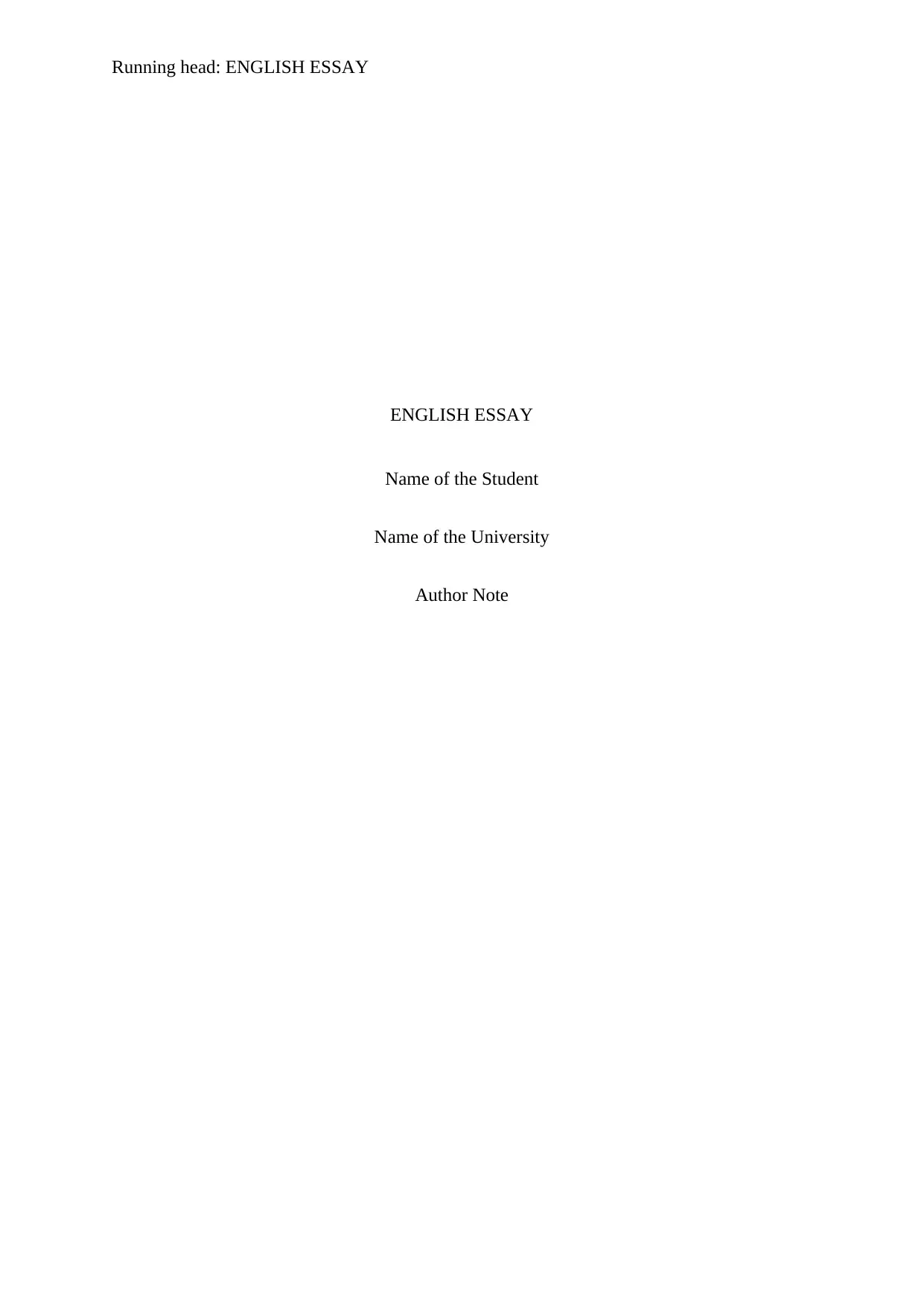
Running head: ENGLISH ESSAY
ENGLISH ESSAY
Name of the Student
Name of the University
Author Note
ENGLISH ESSAY
Name of the Student
Name of the University
Author Note
Paraphrase This Document
Need a fresh take? Get an instant paraphrase of this document with our AI Paraphraser
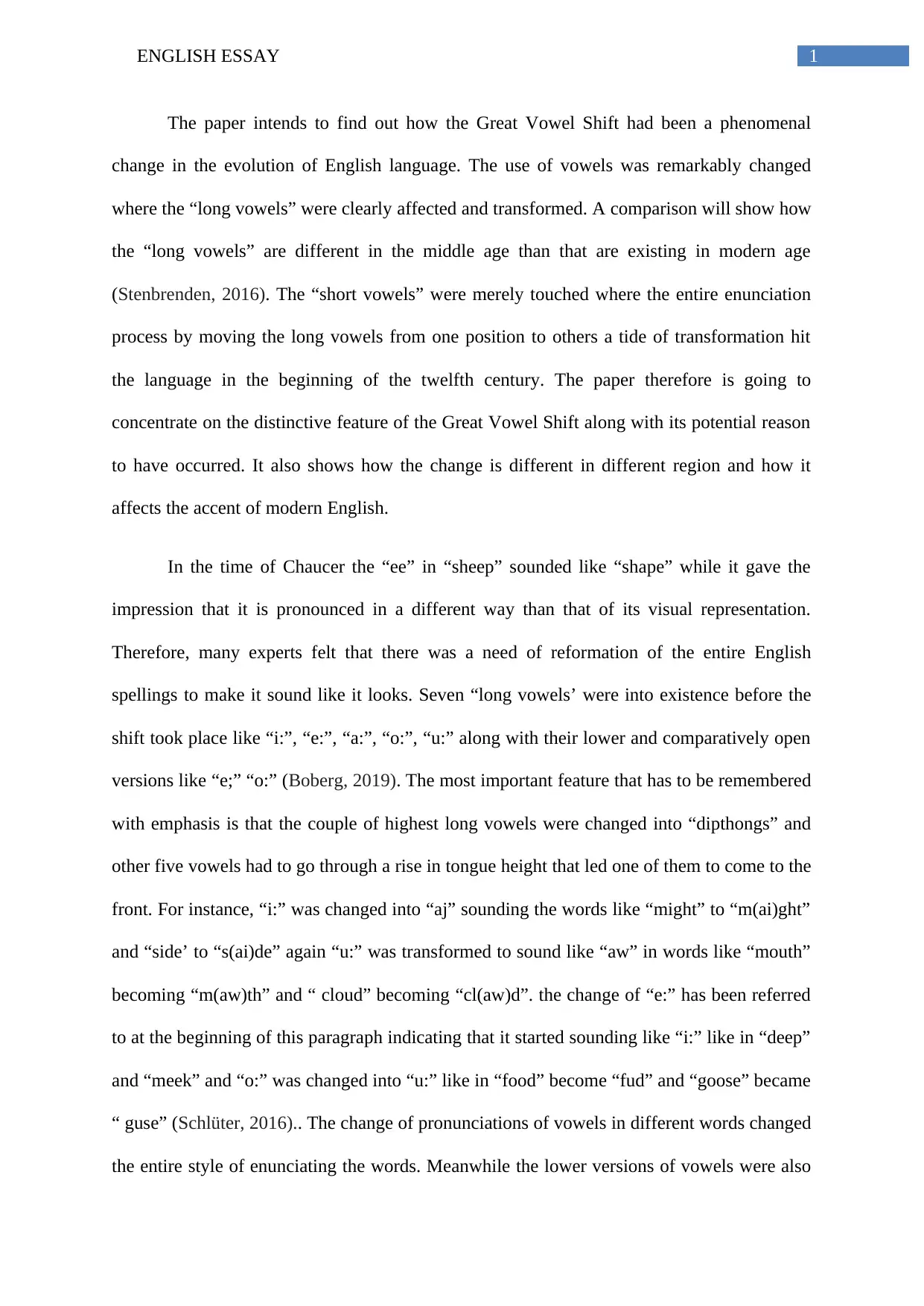
1ENGLISH ESSAY
The paper intends to find out how the Great Vowel Shift had been a phenomenal
change in the evolution of English language. The use of vowels was remarkably changed
where the “long vowels” were clearly affected and transformed. A comparison will show how
the “long vowels” are different in the middle age than that are existing in modern age
(Stenbrenden, 2016). The “short vowels” were merely touched where the entire enunciation
process by moving the long vowels from one position to others a tide of transformation hit
the language in the beginning of the twelfth century. The paper therefore is going to
concentrate on the distinctive feature of the Great Vowel Shift along with its potential reason
to have occurred. It also shows how the change is different in different region and how it
affects the accent of modern English.
In the time of Chaucer the “ee” in “sheep” sounded like “shape” while it gave the
impression that it is pronounced in a different way than that of its visual representation.
Therefore, many experts felt that there was a need of reformation of the entire English
spellings to make it sound like it looks. Seven “long vowels’ were into existence before the
shift took place like “i:”, “e:”, “a:”, “o:”, “u:” along with their lower and comparatively open
versions like “e;” “o:” (Boberg, 2019). The most important feature that has to be remembered
with emphasis is that the couple of highest long vowels were changed into “dipthongs” and
other five vowels had to go through a rise in tongue height that led one of them to come to the
front. For instance, “i:” was changed into “aj” sounding the words like “might” to “m(ai)ght”
and “side’ to “s(ai)de” again “u:” was transformed to sound like “aw” in words like “mouth”
becoming “m(aw)th” and “ cloud” becoming “cl(aw)d”. the change of “e:” has been referred
to at the beginning of this paragraph indicating that it started sounding like “i:” like in “deep”
and “meek” and “o:” was changed into “u:” like in “food” become “fud” and “goose” became
“ guse” (Schlüter, 2016).. The change of pronunciations of vowels in different words changed
the entire style of enunciating the words. Meanwhile the lower versions of vowels were also
The paper intends to find out how the Great Vowel Shift had been a phenomenal
change in the evolution of English language. The use of vowels was remarkably changed
where the “long vowels” were clearly affected and transformed. A comparison will show how
the “long vowels” are different in the middle age than that are existing in modern age
(Stenbrenden, 2016). The “short vowels” were merely touched where the entire enunciation
process by moving the long vowels from one position to others a tide of transformation hit
the language in the beginning of the twelfth century. The paper therefore is going to
concentrate on the distinctive feature of the Great Vowel Shift along with its potential reason
to have occurred. It also shows how the change is different in different region and how it
affects the accent of modern English.
In the time of Chaucer the “ee” in “sheep” sounded like “shape” while it gave the
impression that it is pronounced in a different way than that of its visual representation.
Therefore, many experts felt that there was a need of reformation of the entire English
spellings to make it sound like it looks. Seven “long vowels’ were into existence before the
shift took place like “i:”, “e:”, “a:”, “o:”, “u:” along with their lower and comparatively open
versions like “e;” “o:” (Boberg, 2019). The most important feature that has to be remembered
with emphasis is that the couple of highest long vowels were changed into “dipthongs” and
other five vowels had to go through a rise in tongue height that led one of them to come to the
front. For instance, “i:” was changed into “aj” sounding the words like “might” to “m(ai)ght”
and “side’ to “s(ai)de” again “u:” was transformed to sound like “aw” in words like “mouth”
becoming “m(aw)th” and “ cloud” becoming “cl(aw)d”. the change of “e:” has been referred
to at the beginning of this paragraph indicating that it started sounding like “i:” like in “deep”
and “meek” and “o:” was changed into “u:” like in “food” become “fud” and “goose” became
“ guse” (Schlüter, 2016).. The change of pronunciations of vowels in different words changed
the entire style of enunciating the words. Meanwhile the lower versions of vowels were also
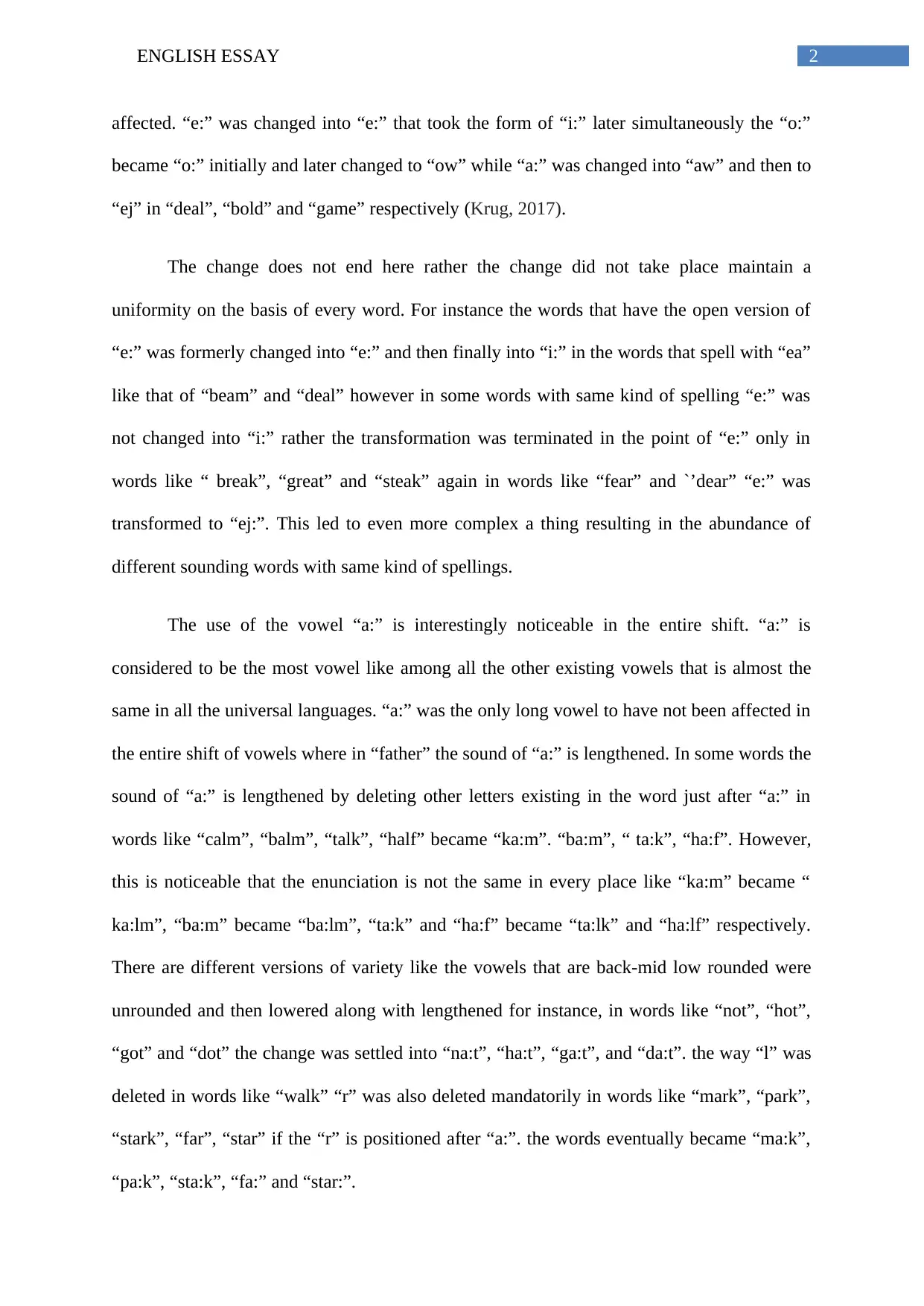
2ENGLISH ESSAY
affected. “e:” was changed into “e:” that took the form of “i:” later simultaneously the “o:”
became “o:” initially and later changed to “ow” while “a:” was changed into “aw” and then to
“ej” in “deal”, “bold” and “game” respectively (Krug, 2017).
The change does not end here rather the change did not take place maintain a
uniformity on the basis of every word. For instance the words that have the open version of
“e:” was formerly changed into “e:” and then finally into “i:” in the words that spell with “ea”
like that of “beam” and “deal” however in some words with same kind of spelling “e:” was
not changed into “i:” rather the transformation was terminated in the point of “e:” only in
words like “ break”, “great” and “steak” again in words like “fear” and `’dear” “e:” was
transformed to “ej:”. This led to even more complex a thing resulting in the abundance of
different sounding words with same kind of spellings.
The use of the vowel “a:” is interestingly noticeable in the entire shift. “a:” is
considered to be the most vowel like among all the other existing vowels that is almost the
same in all the universal languages. “a:” was the only long vowel to have not been affected in
the entire shift of vowels where in “father” the sound of “a:” is lengthened. In some words the
sound of “a:” is lengthened by deleting other letters existing in the word just after “a:” in
words like “calm”, “balm”, “talk”, “half” became “ka:m”. “ba:m”, “ ta:k”, “ha:f”. However,
this is noticeable that the enunciation is not the same in every place like “ka:m” became “
ka:lm”, “ba:m” became “ba:lm”, “ta:k” and “ha:f” became “ta:lk” and “ha:lf” respectively.
There are different versions of variety like the vowels that are back-mid low rounded were
unrounded and then lowered along with lengthened for instance, in words like “not”, “hot”,
“got” and “dot” the change was settled into “na:t”, “ha:t”, “ga:t”, and “da:t”. the way “l” was
deleted in words like “walk” “r” was also deleted mandatorily in words like “mark”, “park”,
“stark”, “far”, “star” if the “r” is positioned after “a:”. the words eventually became “ma:k”,
“pa:k”, “sta:k”, “fa:” and “star:”.
affected. “e:” was changed into “e:” that took the form of “i:” later simultaneously the “o:”
became “o:” initially and later changed to “ow” while “a:” was changed into “aw” and then to
“ej” in “deal”, “bold” and “game” respectively (Krug, 2017).
The change does not end here rather the change did not take place maintain a
uniformity on the basis of every word. For instance the words that have the open version of
“e:” was formerly changed into “e:” and then finally into “i:” in the words that spell with “ea”
like that of “beam” and “deal” however in some words with same kind of spelling “e:” was
not changed into “i:” rather the transformation was terminated in the point of “e:” only in
words like “ break”, “great” and “steak” again in words like “fear” and `’dear” “e:” was
transformed to “ej:”. This led to even more complex a thing resulting in the abundance of
different sounding words with same kind of spellings.
The use of the vowel “a:” is interestingly noticeable in the entire shift. “a:” is
considered to be the most vowel like among all the other existing vowels that is almost the
same in all the universal languages. “a:” was the only long vowel to have not been affected in
the entire shift of vowels where in “father” the sound of “a:” is lengthened. In some words the
sound of “a:” is lengthened by deleting other letters existing in the word just after “a:” in
words like “calm”, “balm”, “talk”, “half” became “ka:m”. “ba:m”, “ ta:k”, “ha:f”. However,
this is noticeable that the enunciation is not the same in every place like “ka:m” became “
ka:lm”, “ba:m” became “ba:lm”, “ta:k” and “ha:f” became “ta:lk” and “ha:lf” respectively.
There are different versions of variety like the vowels that are back-mid low rounded were
unrounded and then lowered along with lengthened for instance, in words like “not”, “hot”,
“got” and “dot” the change was settled into “na:t”, “ha:t”, “ga:t”, and “da:t”. the way “l” was
deleted in words like “walk” “r” was also deleted mandatorily in words like “mark”, “park”,
“stark”, “far”, “star” if the “r” is positioned after “a:”. the words eventually became “ma:k”,
“pa:k”, “sta:k”, “fa:” and “star:”.
⊘ This is a preview!⊘
Do you want full access?
Subscribe today to unlock all pages.

Trusted by 1+ million students worldwide
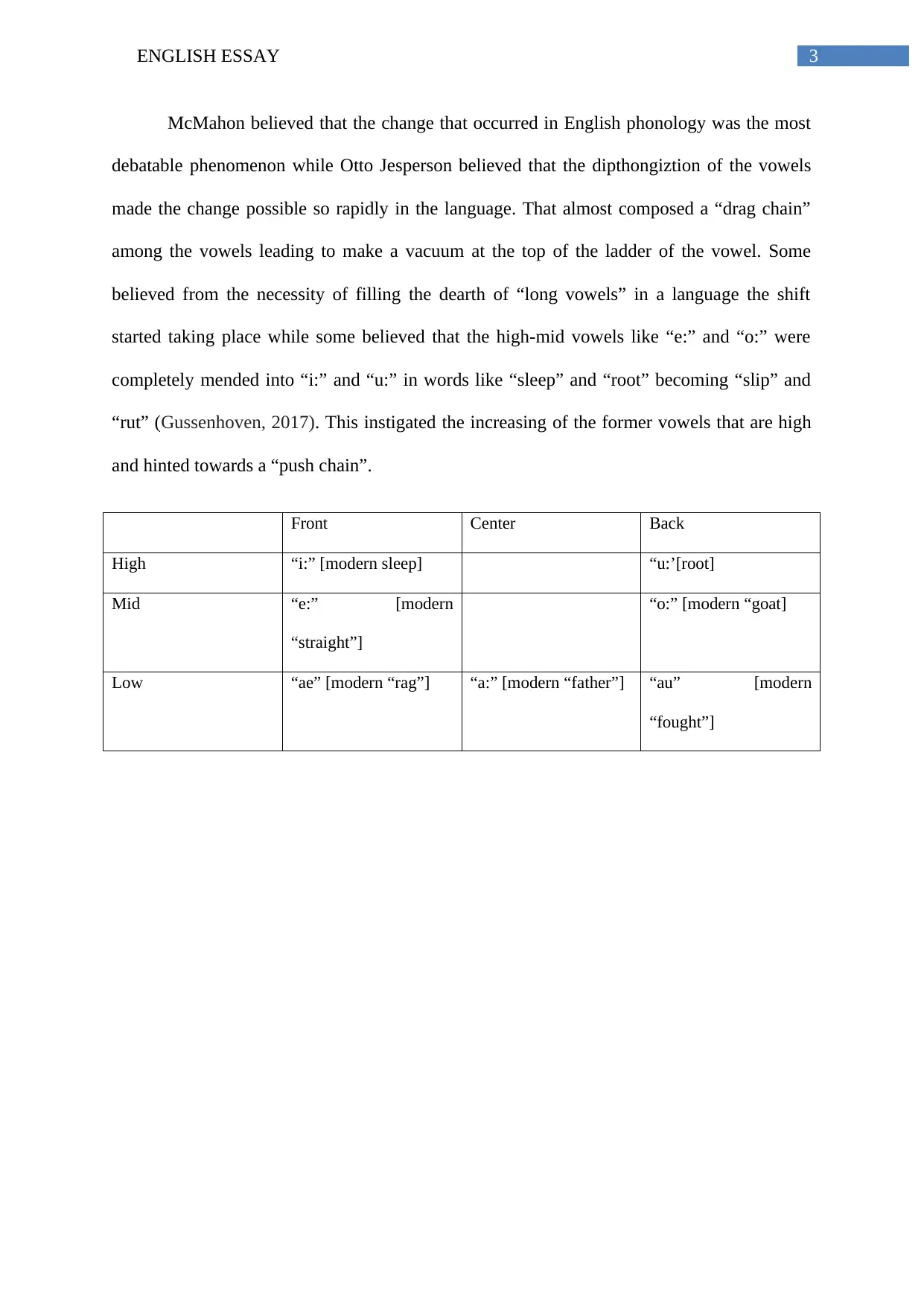
3ENGLISH ESSAY
McMahon believed that the change that occurred in English phonology was the most
debatable phenomenon while Otto Jesperson believed that the dipthongiztion of the vowels
made the change possible so rapidly in the language. That almost composed a “drag chain”
among the vowels leading to make a vacuum at the top of the ladder of the vowel. Some
believed from the necessity of filling the dearth of “long vowels” in a language the shift
started taking place while some believed that the high-mid vowels like “e:” and “o:” were
completely mended into “i:” and “u:” in words like “sleep” and “root” becoming “slip” and
“rut” (Gussenhoven, 2017). This instigated the increasing of the former vowels that are high
and hinted towards a “push chain”.
Front Center Back
High “i:” [modern sleep] “u:’[root]
Mid “e:” [modern
“straight”]
“o:” [modern “goat]
Low “ae” [modern “rag”] “a:” [modern “father”] “au” [modern
“fought”]
McMahon believed that the change that occurred in English phonology was the most
debatable phenomenon while Otto Jesperson believed that the dipthongiztion of the vowels
made the change possible so rapidly in the language. That almost composed a “drag chain”
among the vowels leading to make a vacuum at the top of the ladder of the vowel. Some
believed from the necessity of filling the dearth of “long vowels” in a language the shift
started taking place while some believed that the high-mid vowels like “e:” and “o:” were
completely mended into “i:” and “u:” in words like “sleep” and “root” becoming “slip” and
“rut” (Gussenhoven, 2017). This instigated the increasing of the former vowels that are high
and hinted towards a “push chain”.
Front Center Back
High “i:” [modern sleep] “u:’[root]
Mid “e:” [modern
“straight”]
“o:” [modern “goat]
Low “ae” [modern “rag”] “a:” [modern “father”] “au” [modern
“fought”]
Paraphrase This Document
Need a fresh take? Get an instant paraphrase of this document with our AI Paraphraser
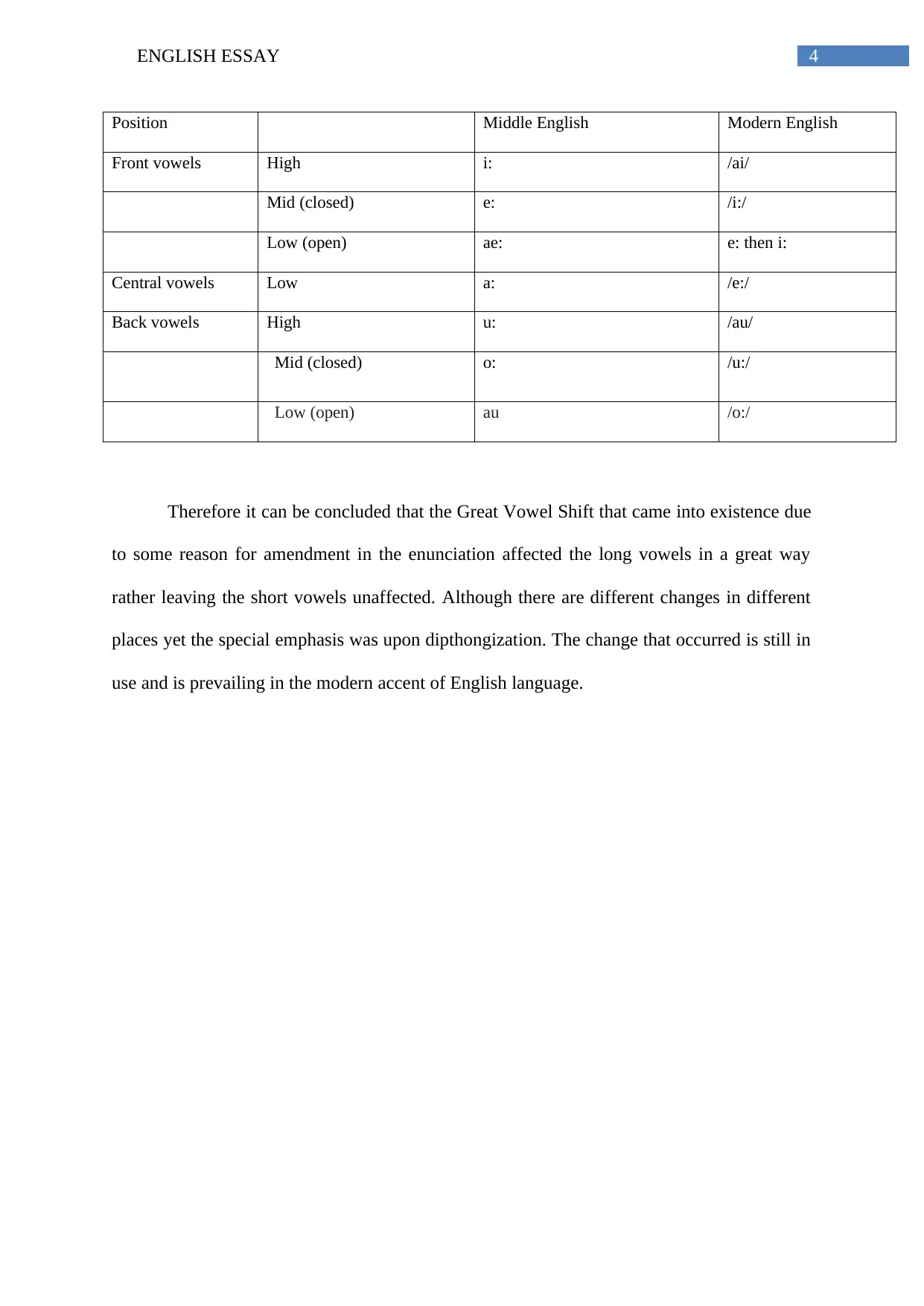
4ENGLISH ESSAY
Position Middle English Modern English
Front vowels High i: /ai/
Mid (closed) e: /i:/
Low (open) ae: e: then i:
Central vowels Low a: /e:/
Back vowels High u: /au/
Mid (closed) o: /u:/
Low (open) au /o:/
Therefore it can be concluded that the Great Vowel Shift that came into existence due
to some reason for amendment in the enunciation affected the long vowels in a great way
rather leaving the short vowels unaffected. Although there are different changes in different
places yet the special emphasis was upon dipthongization. The change that occurred is still in
use and is prevailing in the modern accent of English language.
Position Middle English Modern English
Front vowels High i: /ai/
Mid (closed) e: /i:/
Low (open) ae: e: then i:
Central vowels Low a: /e:/
Back vowels High u: /au/
Mid (closed) o: /u:/
Low (open) au /o:/
Therefore it can be concluded that the Great Vowel Shift that came into existence due
to some reason for amendment in the enunciation affected the long vowels in a great way
rather leaving the short vowels unaffected. Although there are different changes in different
places yet the special emphasis was upon dipthongization. The change that occurred is still in
use and is prevailing in the modern accent of English language.
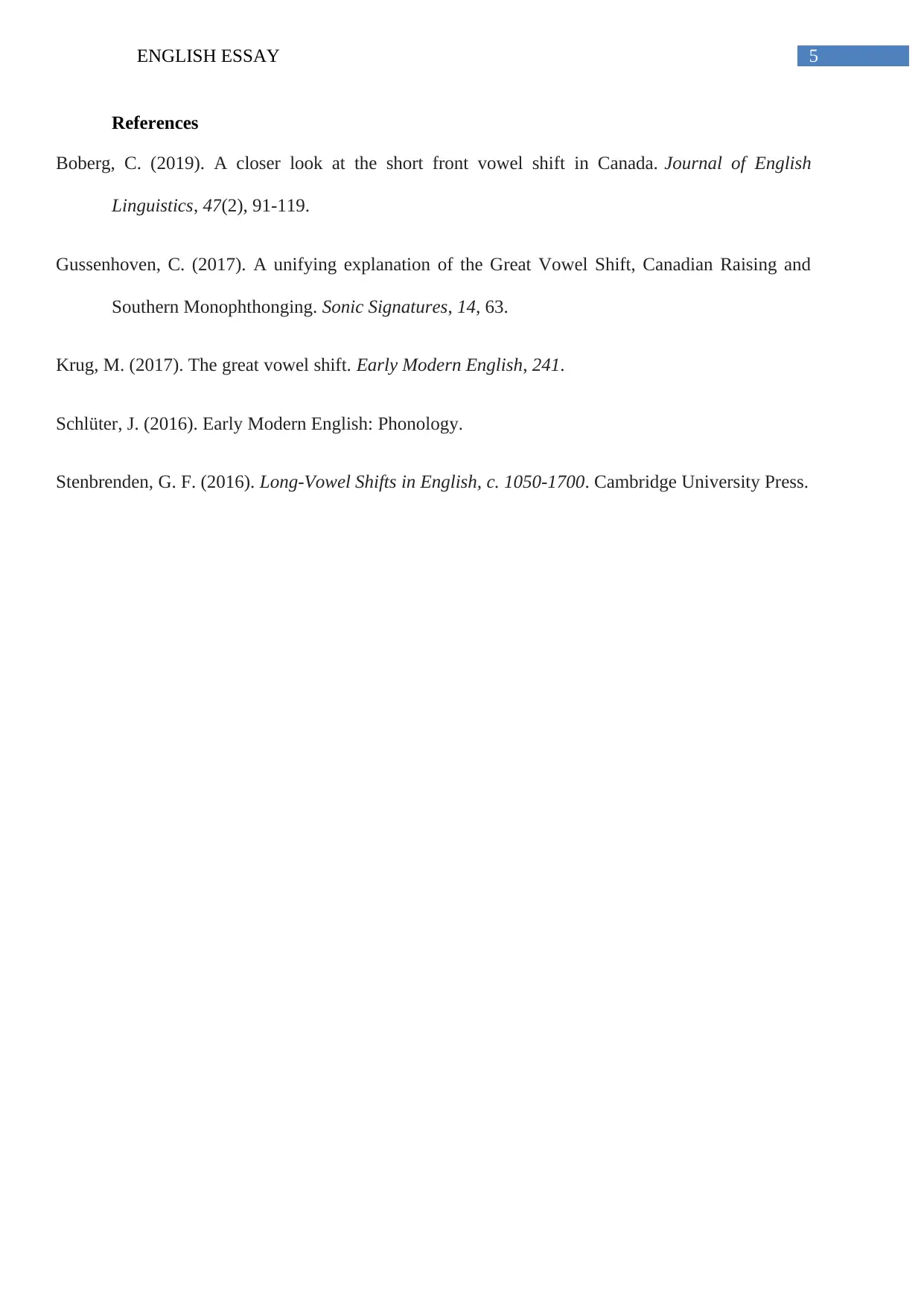
5ENGLISH ESSAY
References
Boberg, C. (2019). A closer look at the short front vowel shift in Canada. Journal of English
Linguistics, 47(2), 91-119.
Gussenhoven, C. (2017). A unifying explanation of the Great Vowel Shift, Canadian Raising and
Southern Monophthonging. Sonic Signatures, 14, 63.
Krug, M. (2017). The great vowel shift. Early Modern English, 241.
Schlüter, J. (2016). Early Modern English: Phonology.
Stenbrenden, G. F. (2016). Long-Vowel Shifts in English, c. 1050-1700. Cambridge University Press.
References
Boberg, C. (2019). A closer look at the short front vowel shift in Canada. Journal of English
Linguistics, 47(2), 91-119.
Gussenhoven, C. (2017). A unifying explanation of the Great Vowel Shift, Canadian Raising and
Southern Monophthonging. Sonic Signatures, 14, 63.
Krug, M. (2017). The great vowel shift. Early Modern English, 241.
Schlüter, J. (2016). Early Modern English: Phonology.
Stenbrenden, G. F. (2016). Long-Vowel Shifts in English, c. 1050-1700. Cambridge University Press.
⊘ This is a preview!⊘
Do you want full access?
Subscribe today to unlock all pages.

Trusted by 1+ million students worldwide
1 out of 6
Related Documents
Your All-in-One AI-Powered Toolkit for Academic Success.
+13062052269
info@desklib.com
Available 24*7 on WhatsApp / Email
![[object Object]](/_next/static/media/star-bottom.7253800d.svg)
Unlock your academic potential
Copyright © 2020–2025 A2Z Services. All Rights Reserved. Developed and managed by ZUCOL.



